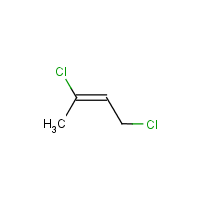1,3-Dichloro-2-butene
Agent Name
1,3-Dichloro-2-butene
CAS Number
926-57-8
Formula
C4-H6-Cl2
Major Category
Other Classes

Synonyms
1,3-Dichlorobutylene; 2-Butene, 1,3-dichloro-; [ChemIDplus] 1,3-DCB; [SIDS UNEP]
Category
Halogenated Aliphatics, Unsaturated
Description
Clear to straw-colored liquid; [HSDB] Colorless liquid; [MSDSonline]
Sources/Uses
Used in the pesticide DDB and as an intermediate in organic synthesis; [HSDB] Commercially manufactured and consumed solely as on-site intermediate in the production of 2,3-dichloro-1,3-butadiene (comonomer for polychloroprene synthetic rubber); [SIDS UNEP]
Comments
A skin, eye, and respiratory tract irritant; Exposure to high vapor concentrations can cause severe respiratory distress, lacrimation, and possibly coma; Inhalation of low concentrations may cause CNS depression; May cause kidney, liver, and heart injury; Emergency medical treatment: "chlorinated hydrocarbon insecticides"; [HSDB] Corrosive to rabbit skin; Occupational exposures demonstrate irritation and corrosive injuries to skin, with the vapor causes eye and respiratory tract irritation; A possible carcinogen based on the structural analog 1,3-Dichloropropene (DCP) CAS # 542-75-6, which has an IARC classification of “possible human carcinogen”; No evidence of reproductive or developmental toxicity in rats or rabbits; [SIDS UNEP]
Biomedical References
Exposure Assessment
Vapor Pressure
12.6 mm Hg
Lethal Concentration
LC50 (rat) = 3,930 mg/m3/4h
Explanatory Notes
Flash point = 27 deg C; [HSDB] VP from ChemIDplus;
NFPA
may ignite at ambient temp
Adverse Effects
Lachrymator
Yes
Neurotoxin
Other CNS neurotoxin
Hepatotoxin
Hepatoxic (a) from occupational exposure (secondary effect) or (b) in animal studies or in humans after ingestion
Dermatotoxin
Skin burns
Diseases, Processes, and Activities Linked to This Agent
Processes
Industrial Processes with risk of exposure: